Advertising and Social Communication: A Comparative Analysis Report
VerifiedAdded on 2022/09/14
|9
|1872
|23
Report
AI Summary
This report provides an in-depth analysis of advertising and social communication, examining key concepts through the lens of two advertisements: Starbucks and Red Bull. The report begins by defining and illustrating the concept of commodification, using Starbucks' coffee promotion as an example of transforming a morning ritual into a commodity. Authenticity in advertising is then explored, highlighting how Starbucks uses real product images to build trust. The report also delves into the aesthetics of advertising, emphasizing the role of visual elements in capturing audience attention, as seen in the Starbucks advertisement's use of warm tones. Heteronormativity is discussed in relation to Red Bull's advertisement, which targets a broad audience regardless of gender. The concept of commodity fetishism is analyzed through Red Bull's tagline, which creates an association between the product and the feeling of energy. Finally, the report examines exclusivity in advertising, pointing out Red Bull's unique tagline as a key selling proposition. The report references several academic sources to support its analysis.
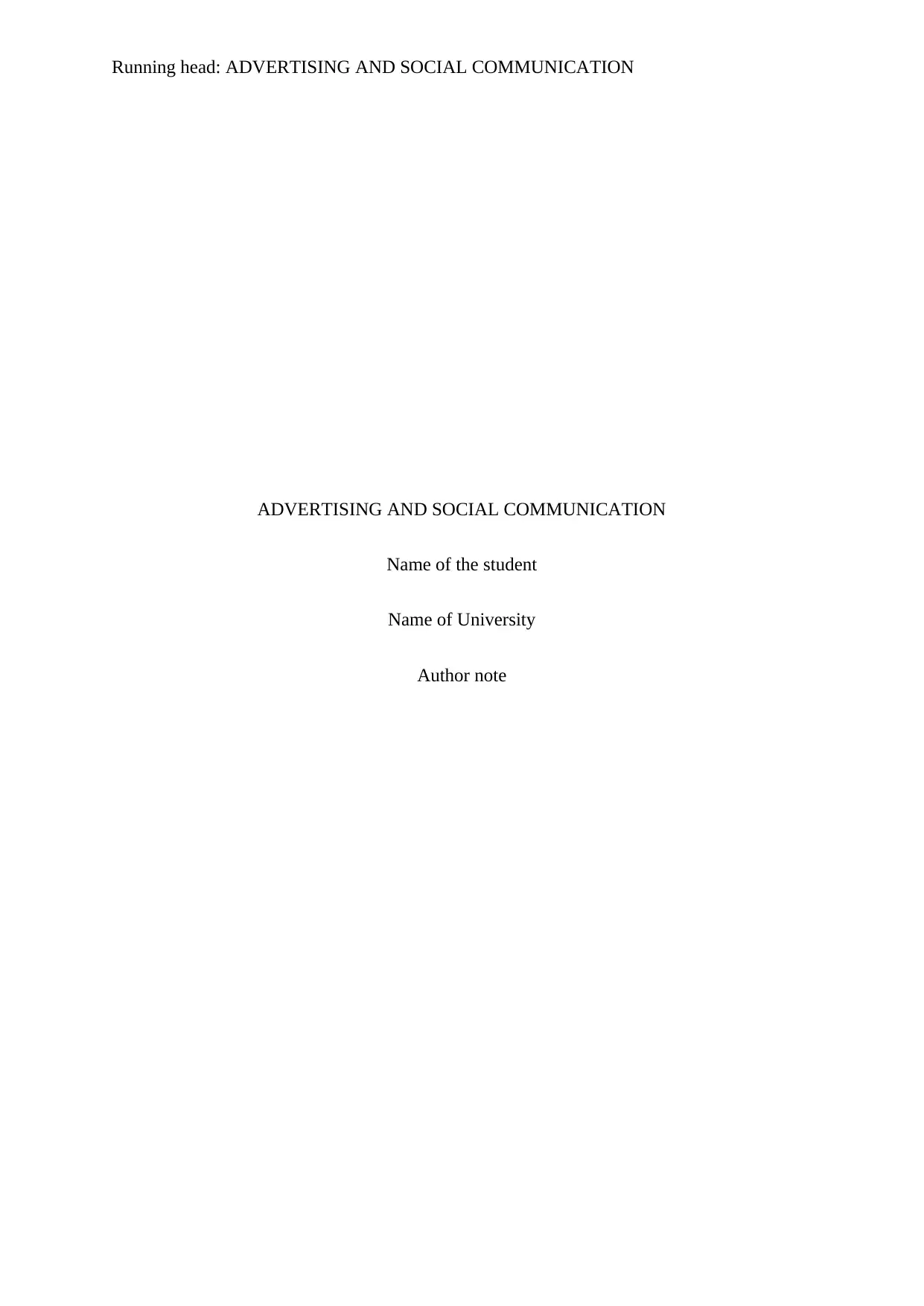
Running head: ADVERTISING AND SOCIAL COMMUNICATION
ADVERTISING AND SOCIAL COMMUNICATION
Name of the student
Name of University
Author note
ADVERTISING AND SOCIAL COMMUNICATION
Name of the student
Name of University
Author note
Paraphrase This Document
Need a fresh take? Get an instant paraphrase of this document with our AI Paraphraser
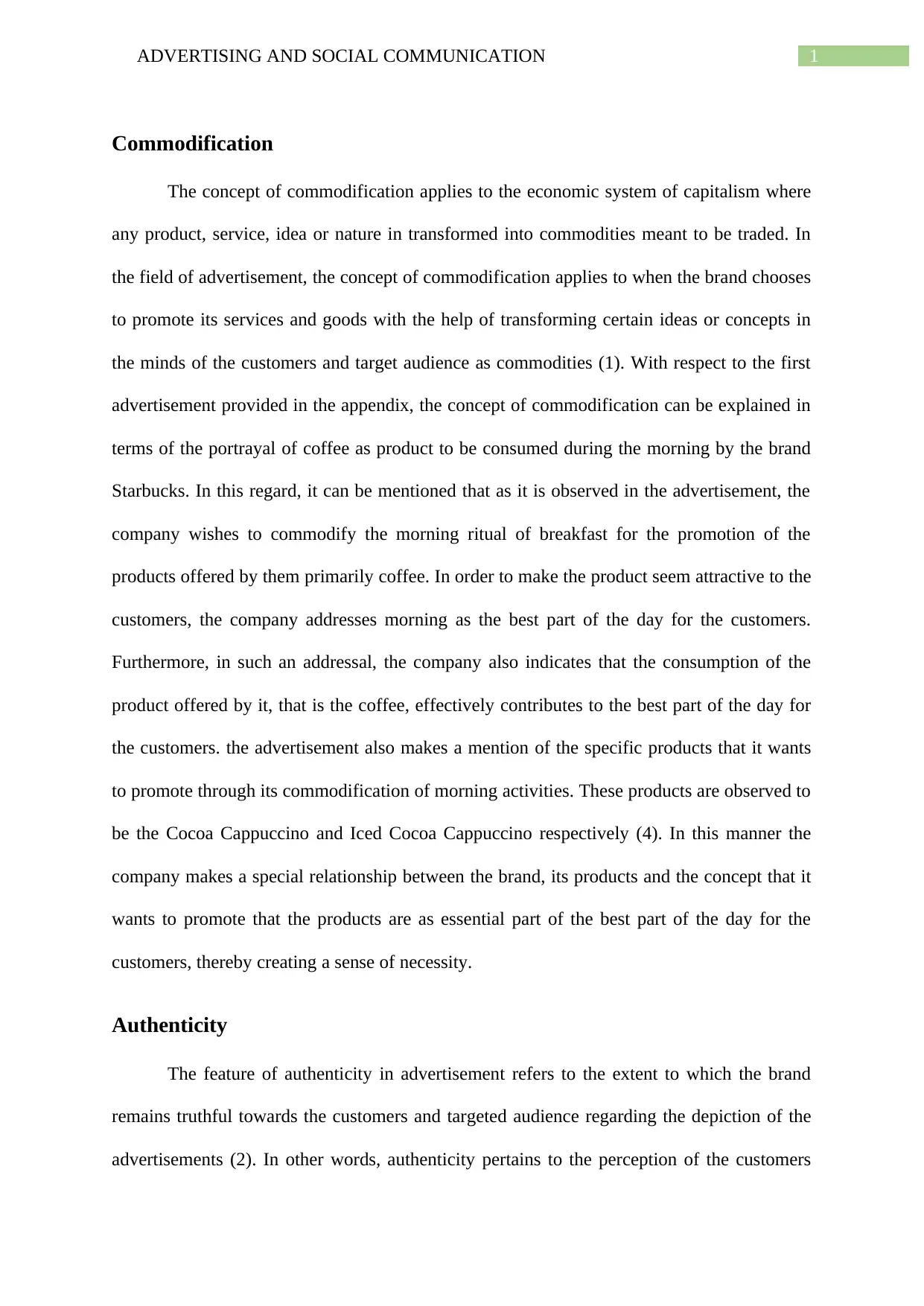
1ADVERTISING AND SOCIAL COMMUNICATION
Commodification
The concept of commodification applies to the economic system of capitalism where
any product, service, idea or nature in transformed into commodities meant to be traded. In
the field of advertisement, the concept of commodification applies to when the brand chooses
to promote its services and goods with the help of transforming certain ideas or concepts in
the minds of the customers and target audience as commodities (1). With respect to the first
advertisement provided in the appendix, the concept of commodification can be explained in
terms of the portrayal of coffee as product to be consumed during the morning by the brand
Starbucks. In this regard, it can be mentioned that as it is observed in the advertisement, the
company wishes to commodify the morning ritual of breakfast for the promotion of the
products offered by them primarily coffee. In order to make the product seem attractive to the
customers, the company addresses morning as the best part of the day for the customers.
Furthermore, in such an addressal, the company also indicates that the consumption of the
product offered by it, that is the coffee, effectively contributes to the best part of the day for
the customers. the advertisement also makes a mention of the specific products that it wants
to promote through its commodification of morning activities. These products are observed to
be the Cocoa Cappuccino and Iced Cocoa Cappuccino respectively (4). In this manner the
company makes a special relationship between the brand, its products and the concept that it
wants to promote that the products are as essential part of the best part of the day for the
customers, thereby creating a sense of necessity.
Authenticity
The feature of authenticity in advertisement refers to the extent to which the brand
remains truthful towards the customers and targeted audience regarding the depiction of the
advertisements (2). In other words, authenticity pertains to the perception of the customers
Commodification
The concept of commodification applies to the economic system of capitalism where
any product, service, idea or nature in transformed into commodities meant to be traded. In
the field of advertisement, the concept of commodification applies to when the brand chooses
to promote its services and goods with the help of transforming certain ideas or concepts in
the minds of the customers and target audience as commodities (1). With respect to the first
advertisement provided in the appendix, the concept of commodification can be explained in
terms of the portrayal of coffee as product to be consumed during the morning by the brand
Starbucks. In this regard, it can be mentioned that as it is observed in the advertisement, the
company wishes to commodify the morning ritual of breakfast for the promotion of the
products offered by them primarily coffee. In order to make the product seem attractive to the
customers, the company addresses morning as the best part of the day for the customers.
Furthermore, in such an addressal, the company also indicates that the consumption of the
product offered by it, that is the coffee, effectively contributes to the best part of the day for
the customers. the advertisement also makes a mention of the specific products that it wants
to promote through its commodification of morning activities. These products are observed to
be the Cocoa Cappuccino and Iced Cocoa Cappuccino respectively (4). In this manner the
company makes a special relationship between the brand, its products and the concept that it
wants to promote that the products are as essential part of the best part of the day for the
customers, thereby creating a sense of necessity.
Authenticity
The feature of authenticity in advertisement refers to the extent to which the brand
remains truthful towards the customers and targeted audience regarding the depiction of the
advertisements (2). In other words, authenticity pertains to the perception of the customers
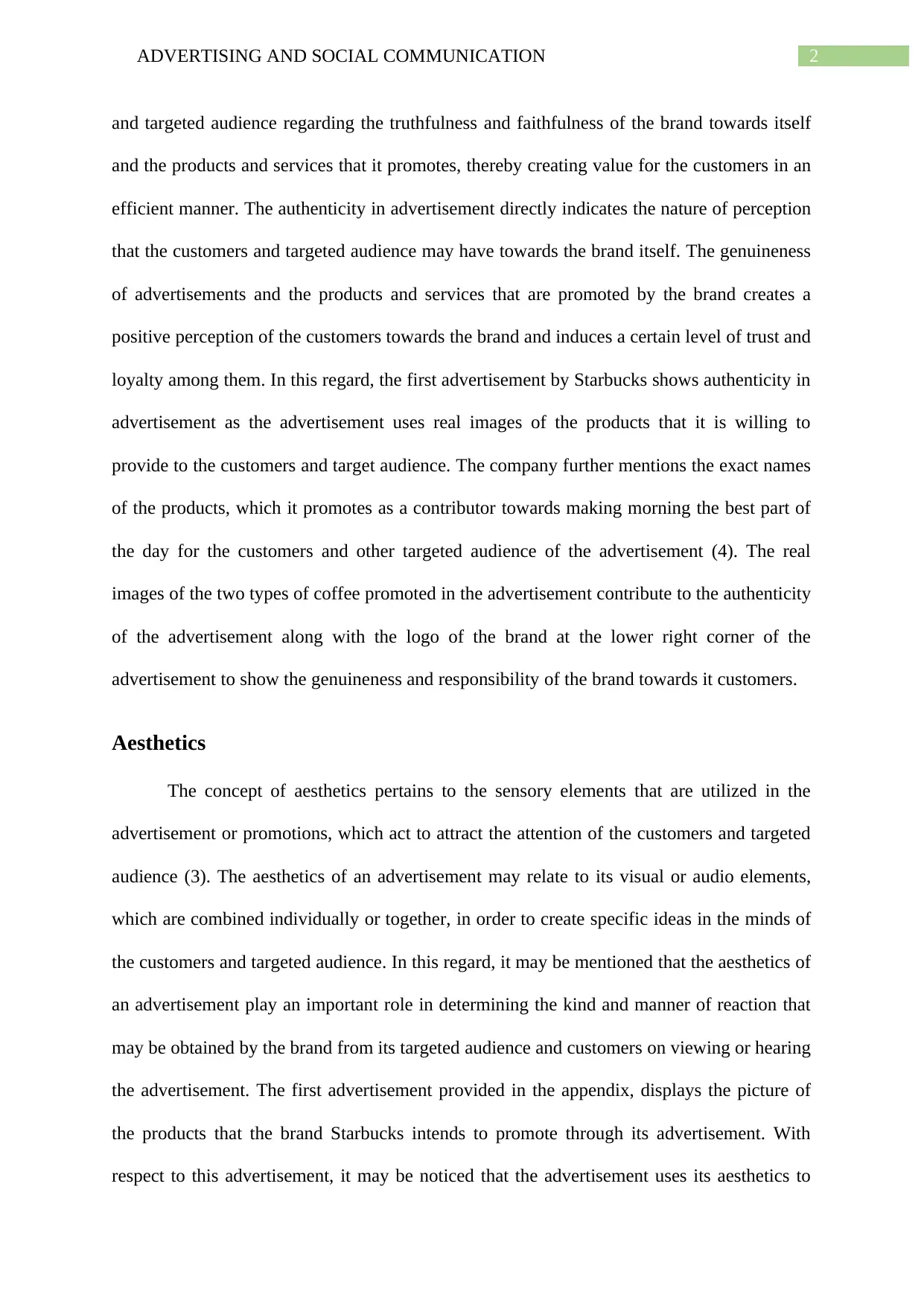
2ADVERTISING AND SOCIAL COMMUNICATION
and targeted audience regarding the truthfulness and faithfulness of the brand towards itself
and the products and services that it promotes, thereby creating value for the customers in an
efficient manner. The authenticity in advertisement directly indicates the nature of perception
that the customers and targeted audience may have towards the brand itself. The genuineness
of advertisements and the products and services that are promoted by the brand creates a
positive perception of the customers towards the brand and induces a certain level of trust and
loyalty among them. In this regard, the first advertisement by Starbucks shows authenticity in
advertisement as the advertisement uses real images of the products that it is willing to
provide to the customers and target audience. The company further mentions the exact names
of the products, which it promotes as a contributor towards making morning the best part of
the day for the customers and other targeted audience of the advertisement (4). The real
images of the two types of coffee promoted in the advertisement contribute to the authenticity
of the advertisement along with the logo of the brand at the lower right corner of the
advertisement to show the genuineness and responsibility of the brand towards it customers.
Aesthetics
The concept of aesthetics pertains to the sensory elements that are utilized in the
advertisement or promotions, which act to attract the attention of the customers and targeted
audience (3). The aesthetics of an advertisement may relate to its visual or audio elements,
which are combined individually or together, in order to create specific ideas in the minds of
the customers and targeted audience. In this regard, it may be mentioned that the aesthetics of
an advertisement play an important role in determining the kind and manner of reaction that
may be obtained by the brand from its targeted audience and customers on viewing or hearing
the advertisement. The first advertisement provided in the appendix, displays the picture of
the products that the brand Starbucks intends to promote through its advertisement. With
respect to this advertisement, it may be noticed that the advertisement uses its aesthetics to
and targeted audience regarding the truthfulness and faithfulness of the brand towards itself
and the products and services that it promotes, thereby creating value for the customers in an
efficient manner. The authenticity in advertisement directly indicates the nature of perception
that the customers and targeted audience may have towards the brand itself. The genuineness
of advertisements and the products and services that are promoted by the brand creates a
positive perception of the customers towards the brand and induces a certain level of trust and
loyalty among them. In this regard, the first advertisement by Starbucks shows authenticity in
advertisement as the advertisement uses real images of the products that it is willing to
provide to the customers and target audience. The company further mentions the exact names
of the products, which it promotes as a contributor towards making morning the best part of
the day for the customers and other targeted audience of the advertisement (4). The real
images of the two types of coffee promoted in the advertisement contribute to the authenticity
of the advertisement along with the logo of the brand at the lower right corner of the
advertisement to show the genuineness and responsibility of the brand towards it customers.
Aesthetics
The concept of aesthetics pertains to the sensory elements that are utilized in the
advertisement or promotions, which act to attract the attention of the customers and targeted
audience (3). The aesthetics of an advertisement may relate to its visual or audio elements,
which are combined individually or together, in order to create specific ideas in the minds of
the customers and targeted audience. In this regard, it may be mentioned that the aesthetics of
an advertisement play an important role in determining the kind and manner of reaction that
may be obtained by the brand from its targeted audience and customers on viewing or hearing
the advertisement. The first advertisement provided in the appendix, displays the picture of
the products that the brand Starbucks intends to promote through its advertisement. With
respect to this advertisement, it may be noticed that the advertisement uses its aesthetics to
⊘ This is a preview!⊘
Do you want full access?
Subscribe today to unlock all pages.

Trusted by 1+ million students worldwide
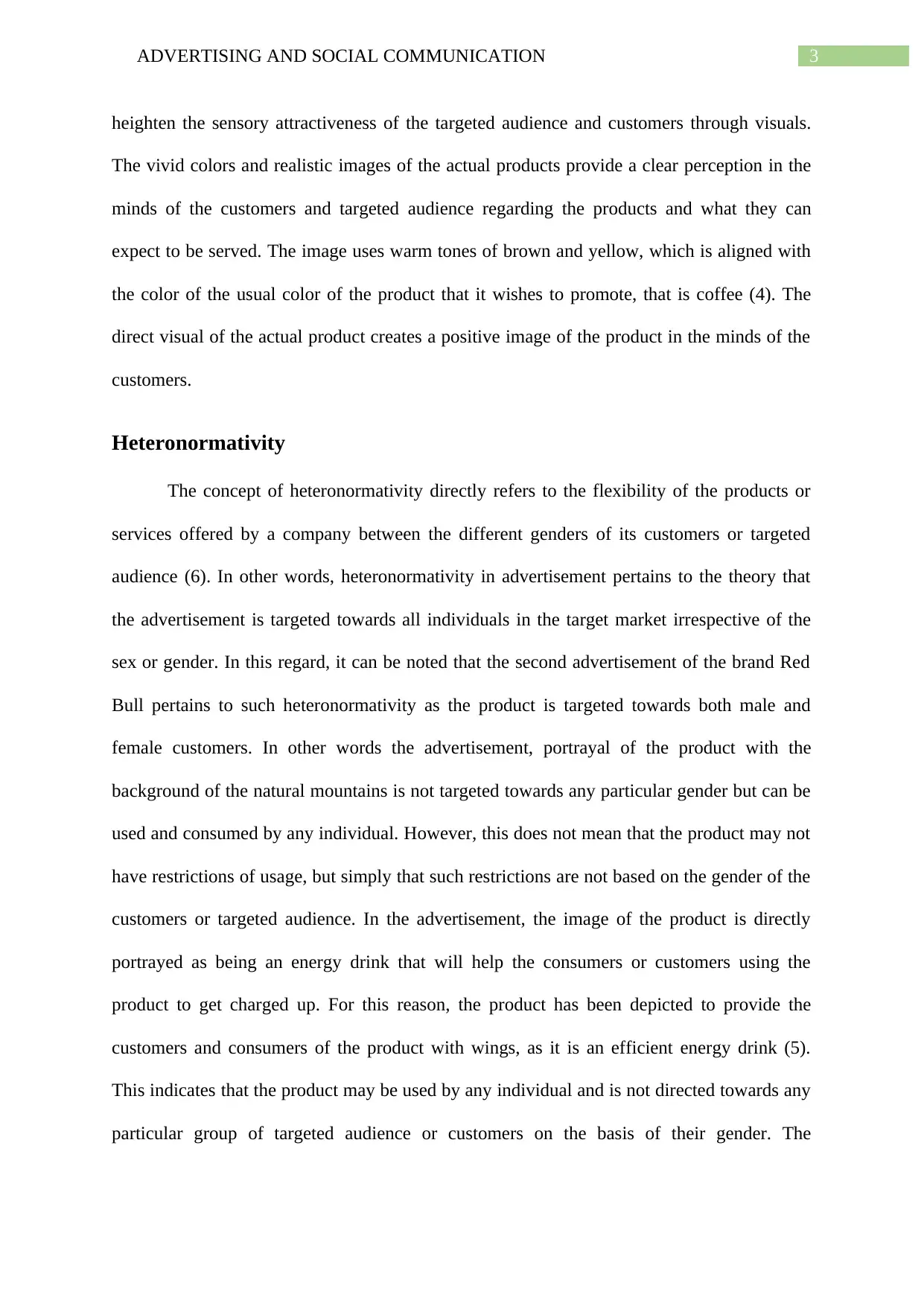
3ADVERTISING AND SOCIAL COMMUNICATION
heighten the sensory attractiveness of the targeted audience and customers through visuals.
The vivid colors and realistic images of the actual products provide a clear perception in the
minds of the customers and targeted audience regarding the products and what they can
expect to be served. The image uses warm tones of brown and yellow, which is aligned with
the color of the usual color of the product that it wishes to promote, that is coffee (4). The
direct visual of the actual product creates a positive image of the product in the minds of the
customers.
Heteronormativity
The concept of heteronormativity directly refers to the flexibility of the products or
services offered by a company between the different genders of its customers or targeted
audience (6). In other words, heteronormativity in advertisement pertains to the theory that
the advertisement is targeted towards all individuals in the target market irrespective of the
sex or gender. In this regard, it can be noted that the second advertisement of the brand Red
Bull pertains to such heteronormativity as the product is targeted towards both male and
female customers. In other words the advertisement, portrayal of the product with the
background of the natural mountains is not targeted towards any particular gender but can be
used and consumed by any individual. However, this does not mean that the product may not
have restrictions of usage, but simply that such restrictions are not based on the gender of the
customers or targeted audience. In the advertisement, the image of the product is directly
portrayed as being an energy drink that will help the consumers or customers using the
product to get charged up. For this reason, the product has been depicted to provide the
customers and consumers of the product with wings, as it is an efficient energy drink (5).
This indicates that the product may be used by any individual and is not directed towards any
particular group of targeted audience or customers on the basis of their gender. The
heighten the sensory attractiveness of the targeted audience and customers through visuals.
The vivid colors and realistic images of the actual products provide a clear perception in the
minds of the customers and targeted audience regarding the products and what they can
expect to be served. The image uses warm tones of brown and yellow, which is aligned with
the color of the usual color of the product that it wishes to promote, that is coffee (4). The
direct visual of the actual product creates a positive image of the product in the minds of the
customers.
Heteronormativity
The concept of heteronormativity directly refers to the flexibility of the products or
services offered by a company between the different genders of its customers or targeted
audience (6). In other words, heteronormativity in advertisement pertains to the theory that
the advertisement is targeted towards all individuals in the target market irrespective of the
sex or gender. In this regard, it can be noted that the second advertisement of the brand Red
Bull pertains to such heteronormativity as the product is targeted towards both male and
female customers. In other words the advertisement, portrayal of the product with the
background of the natural mountains is not targeted towards any particular gender but can be
used and consumed by any individual. However, this does not mean that the product may not
have restrictions of usage, but simply that such restrictions are not based on the gender of the
customers or targeted audience. In the advertisement, the image of the product is directly
portrayed as being an energy drink that will help the consumers or customers using the
product to get charged up. For this reason, the product has been depicted to provide the
customers and consumers of the product with wings, as it is an efficient energy drink (5).
This indicates that the product may be used by any individual and is not directed towards any
particular group of targeted audience or customers on the basis of their gender. The
Paraphrase This Document
Need a fresh take? Get an instant paraphrase of this document with our AI Paraphraser
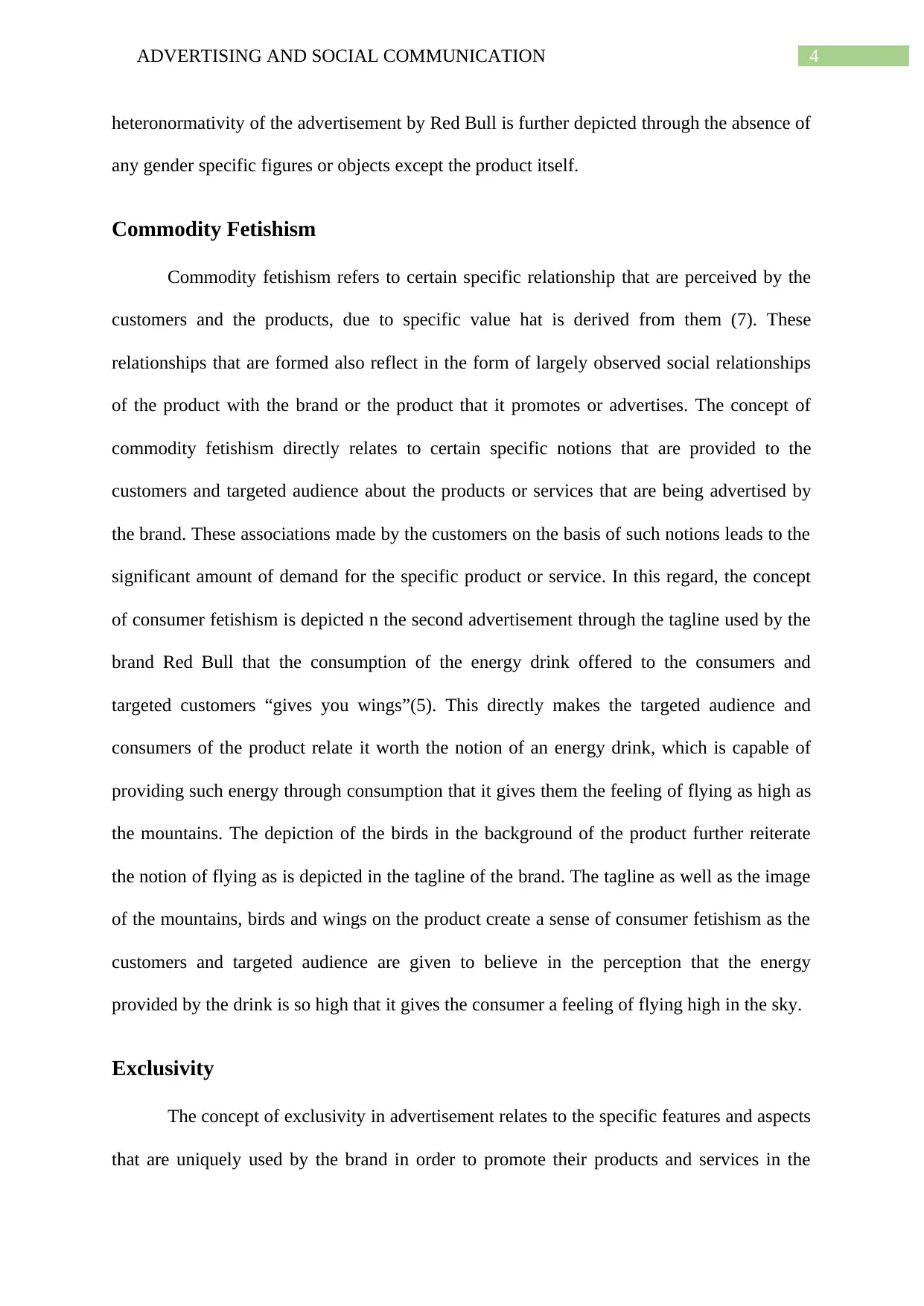
4ADVERTISING AND SOCIAL COMMUNICATION
heteronormativity of the advertisement by Red Bull is further depicted through the absence of
any gender specific figures or objects except the product itself.
Commodity Fetishism
Commodity fetishism refers to certain specific relationship that are perceived by the
customers and the products, due to specific value hat is derived from them (7). These
relationships that are formed also reflect in the form of largely observed social relationships
of the product with the brand or the product that it promotes or advertises. The concept of
commodity fetishism directly relates to certain specific notions that are provided to the
customers and targeted audience about the products or services that are being advertised by
the brand. These associations made by the customers on the basis of such notions leads to the
significant amount of demand for the specific product or service. In this regard, the concept
of consumer fetishism is depicted n the second advertisement through the tagline used by the
brand Red Bull that the consumption of the energy drink offered to the consumers and
targeted customers “gives you wings”(5). This directly makes the targeted audience and
consumers of the product relate it worth the notion of an energy drink, which is capable of
providing such energy through consumption that it gives them the feeling of flying as high as
the mountains. The depiction of the birds in the background of the product further reiterate
the notion of flying as is depicted in the tagline of the brand. The tagline as well as the image
of the mountains, birds and wings on the product create a sense of consumer fetishism as the
customers and targeted audience are given to believe in the perception that the energy
provided by the drink is so high that it gives the consumer a feeling of flying high in the sky.
Exclusivity
The concept of exclusivity in advertisement relates to the specific features and aspects
that are uniquely used by the brand in order to promote their products and services in the
heteronormativity of the advertisement by Red Bull is further depicted through the absence of
any gender specific figures or objects except the product itself.
Commodity Fetishism
Commodity fetishism refers to certain specific relationship that are perceived by the
customers and the products, due to specific value hat is derived from them (7). These
relationships that are formed also reflect in the form of largely observed social relationships
of the product with the brand or the product that it promotes or advertises. The concept of
commodity fetishism directly relates to certain specific notions that are provided to the
customers and targeted audience about the products or services that are being advertised by
the brand. These associations made by the customers on the basis of such notions leads to the
significant amount of demand for the specific product or service. In this regard, the concept
of consumer fetishism is depicted n the second advertisement through the tagline used by the
brand Red Bull that the consumption of the energy drink offered to the consumers and
targeted customers “gives you wings”(5). This directly makes the targeted audience and
consumers of the product relate it worth the notion of an energy drink, which is capable of
providing such energy through consumption that it gives them the feeling of flying as high as
the mountains. The depiction of the birds in the background of the product further reiterate
the notion of flying as is depicted in the tagline of the brand. The tagline as well as the image
of the mountains, birds and wings on the product create a sense of consumer fetishism as the
customers and targeted audience are given to believe in the perception that the energy
provided by the drink is so high that it gives the consumer a feeling of flying high in the sky.
Exclusivity
The concept of exclusivity in advertisement relates to the specific features and aspects
that are uniquely used by the brand in order to promote their products and services in the
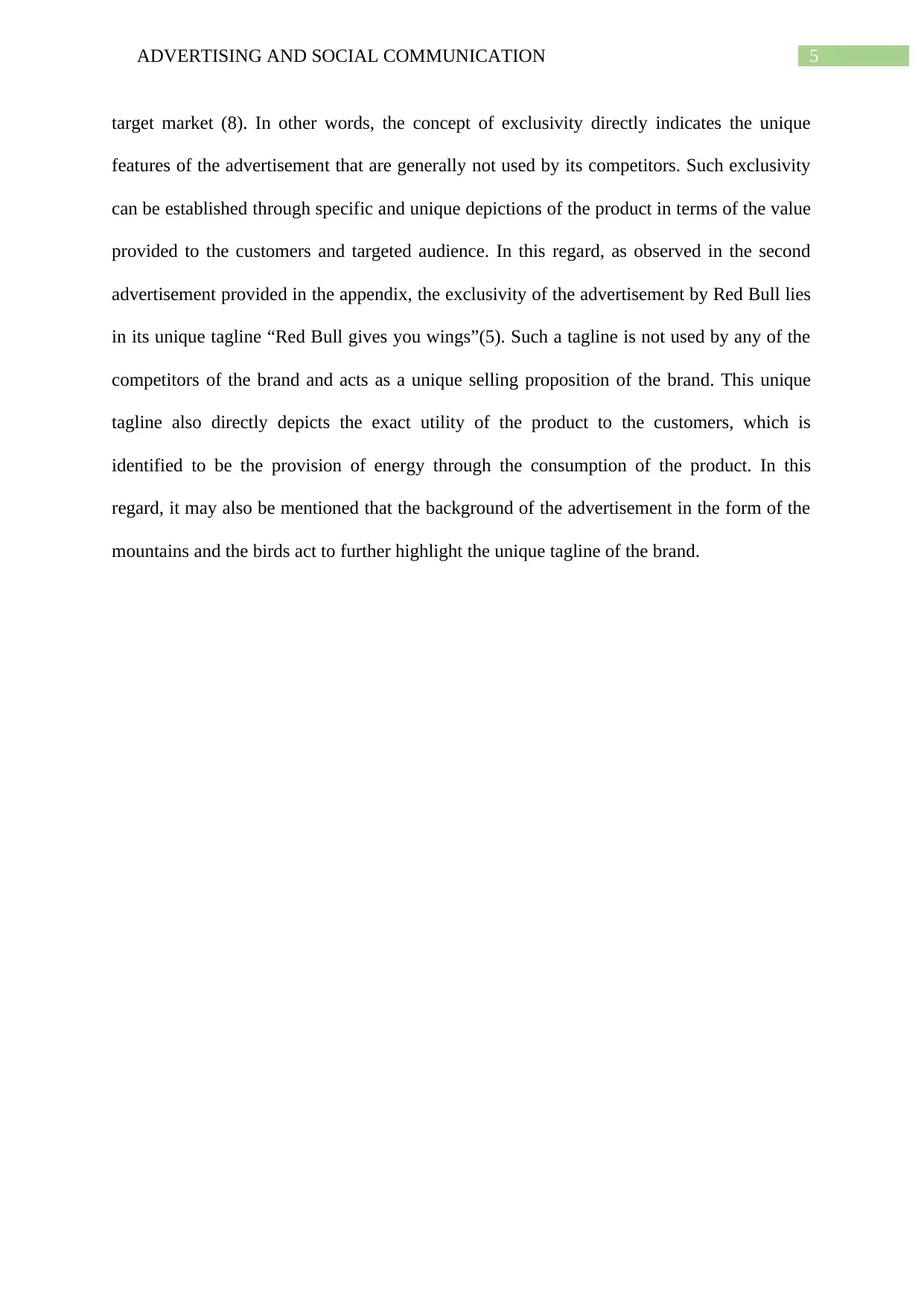
5ADVERTISING AND SOCIAL COMMUNICATION
target market (8). In other words, the concept of exclusivity directly indicates the unique
features of the advertisement that are generally not used by its competitors. Such exclusivity
can be established through specific and unique depictions of the product in terms of the value
provided to the customers and targeted audience. In this regard, as observed in the second
advertisement provided in the appendix, the exclusivity of the advertisement by Red Bull lies
in its unique tagline “Red Bull gives you wings”(5). Such a tagline is not used by any of the
competitors of the brand and acts as a unique selling proposition of the brand. This unique
tagline also directly depicts the exact utility of the product to the customers, which is
identified to be the provision of energy through the consumption of the product. In this
regard, it may also be mentioned that the background of the advertisement in the form of the
mountains and the birds act to further highlight the unique tagline of the brand.
target market (8). In other words, the concept of exclusivity directly indicates the unique
features of the advertisement that are generally not used by its competitors. Such exclusivity
can be established through specific and unique depictions of the product in terms of the value
provided to the customers and targeted audience. In this regard, as observed in the second
advertisement provided in the appendix, the exclusivity of the advertisement by Red Bull lies
in its unique tagline “Red Bull gives you wings”(5). Such a tagline is not used by any of the
competitors of the brand and acts as a unique selling proposition of the brand. This unique
tagline also directly depicts the exact utility of the product to the customers, which is
identified to be the provision of energy through the consumption of the product. In this
regard, it may also be mentioned that the background of the advertisement in the form of the
mountains and the birds act to further highlight the unique tagline of the brand.
⊘ This is a preview!⊘
Do you want full access?
Subscribe today to unlock all pages.

Trusted by 1+ million students worldwide
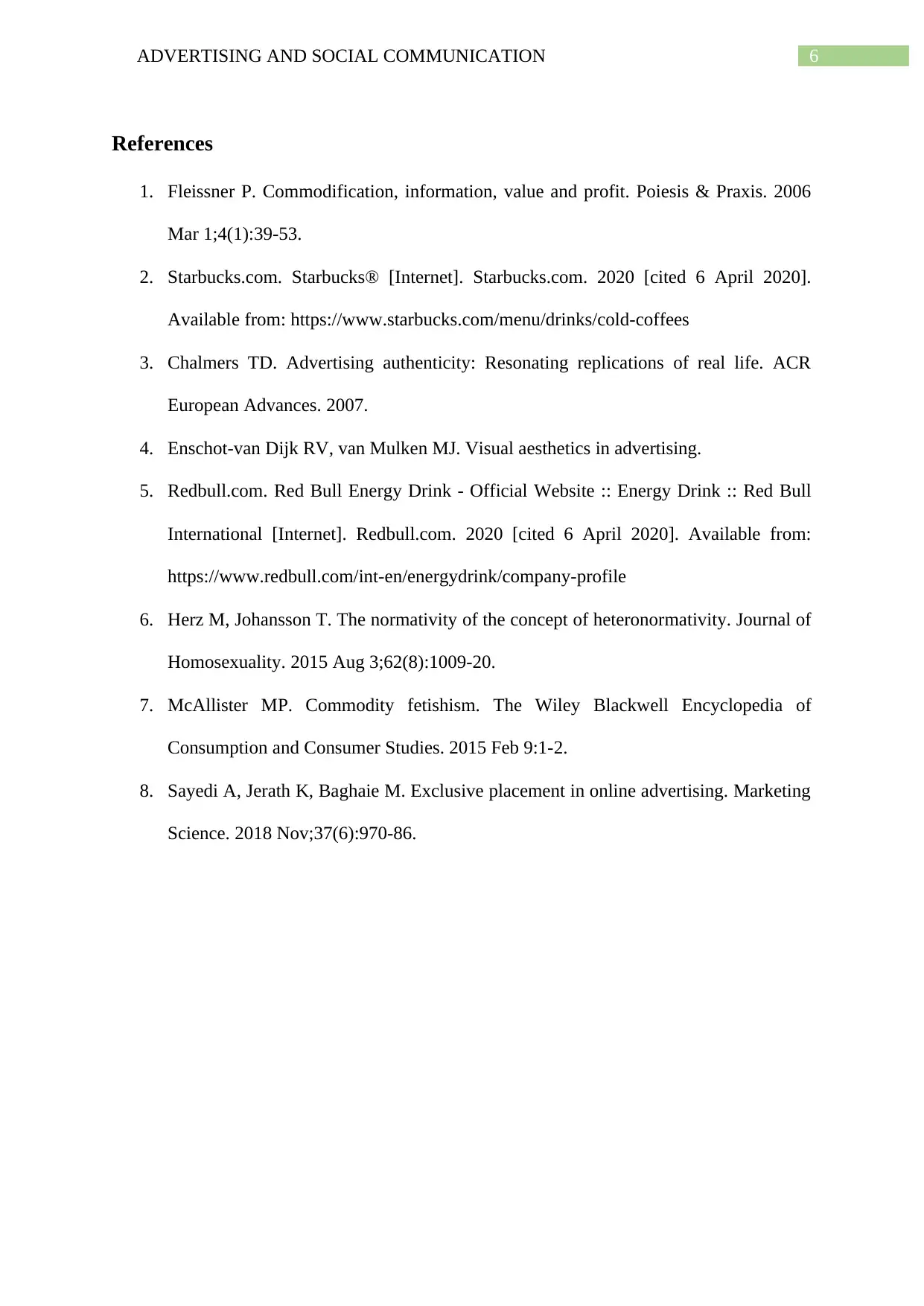
6ADVERTISING AND SOCIAL COMMUNICATION
References
1. Fleissner P. Commodification, information, value and profit. Poiesis & Praxis. 2006
Mar 1;4(1):39-53.
2. Starbucks.com. Starbucks® [Internet]. Starbucks.com. 2020 [cited 6 April 2020].
Available from: https://www.starbucks.com/menu/drinks/cold-coffees
3. Chalmers TD. Advertising authenticity: Resonating replications of real life. ACR
European Advances. 2007.
4. Enschot-van Dijk RV, van Mulken MJ. Visual aesthetics in advertising.
5. Redbull.com. Red Bull Energy Drink - Official Website :: Energy Drink :: Red Bull
International [Internet]. Redbull.com. 2020 [cited 6 April 2020]. Available from:
https://www.redbull.com/int-en/energydrink/company-profile
6. Herz M, Johansson T. The normativity of the concept of heteronormativity. Journal of
Homosexuality. 2015 Aug 3;62(8):1009-20.
7. McAllister MP. Commodity fetishism. The Wiley Blackwell Encyclopedia of
Consumption and Consumer Studies. 2015 Feb 9:1-2.
8. Sayedi A, Jerath K, Baghaie M. Exclusive placement in online advertising. Marketing
Science. 2018 Nov;37(6):970-86.
References
1. Fleissner P. Commodification, information, value and profit. Poiesis & Praxis. 2006
Mar 1;4(1):39-53.
2. Starbucks.com. Starbucks® [Internet]. Starbucks.com. 2020 [cited 6 April 2020].
Available from: https://www.starbucks.com/menu/drinks/cold-coffees
3. Chalmers TD. Advertising authenticity: Resonating replications of real life. ACR
European Advances. 2007.
4. Enschot-van Dijk RV, van Mulken MJ. Visual aesthetics in advertising.
5. Redbull.com. Red Bull Energy Drink - Official Website :: Energy Drink :: Red Bull
International [Internet]. Redbull.com. 2020 [cited 6 April 2020]. Available from:
https://www.redbull.com/int-en/energydrink/company-profile
6. Herz M, Johansson T. The normativity of the concept of heteronormativity. Journal of
Homosexuality. 2015 Aug 3;62(8):1009-20.
7. McAllister MP. Commodity fetishism. The Wiley Blackwell Encyclopedia of
Consumption and Consumer Studies. 2015 Feb 9:1-2.
8. Sayedi A, Jerath K, Baghaie M. Exclusive placement in online advertising. Marketing
Science. 2018 Nov;37(6):970-86.
Paraphrase This Document
Need a fresh take? Get an instant paraphrase of this document with our AI Paraphraser
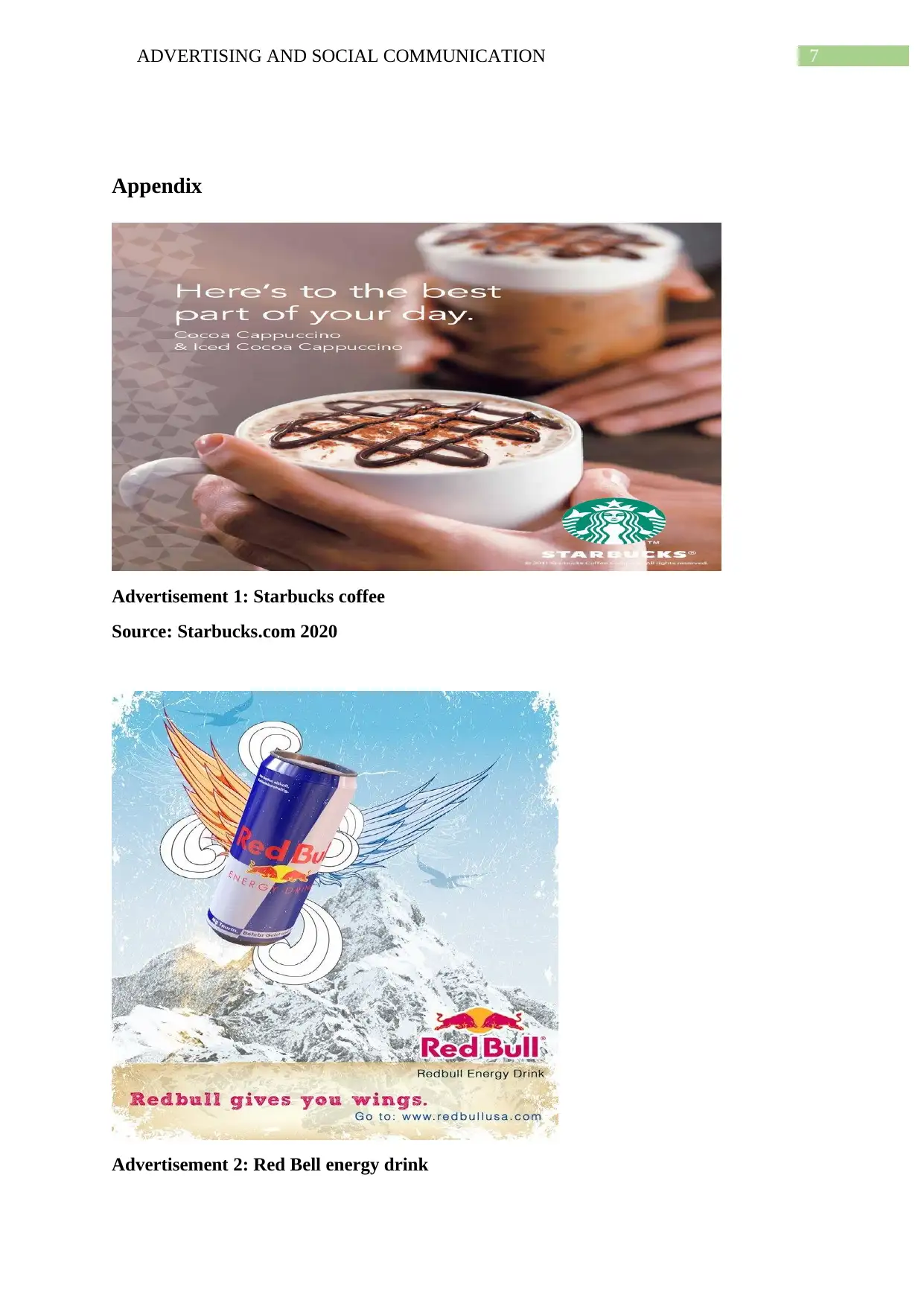
7ADVERTISING AND SOCIAL COMMUNICATION
Appendix
Advertisement 1: Starbucks coffee
Source: Starbucks.com 2020
Advertisement 2: Red Bell energy drink
Appendix
Advertisement 1: Starbucks coffee
Source: Starbucks.com 2020
Advertisement 2: Red Bell energy drink

8ADVERTISING AND SOCIAL COMMUNICATION
Source: Redbull.com 2020
Source: Redbull.com 2020
⊘ This is a preview!⊘
Do you want full access?
Subscribe today to unlock all pages.

Trusted by 1+ million students worldwide
1 out of 9
Related Documents
Your All-in-One AI-Powered Toolkit for Academic Success.
+13062052269
info@desklib.com
Available 24*7 on WhatsApp / Email
![[object Object]](/_next/static/media/star-bottom.7253800d.svg)
Unlock your academic potential
Copyright © 2020–2025 A2Z Services. All Rights Reserved. Developed and managed by ZUCOL.





